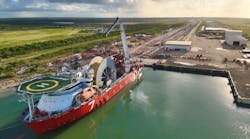Offshore staff
STAVANGER, Norway – Statoil says that the world’s first subsea wet-gas compressor station is now ready for the final testing at Horsøy outside Bergen, Norway, before being prepared for installation and hook-up to Gullfaks C in 2015.
Starting back in 2008, the efforts to develop and qualify the compressor in line with Statoil’s requirements represent a good example of Statoil’s cooperation with the Norwegian supply industry to develop robust improved oil recovery solutions.
“The compressor in principle builds on OneSubsea’s multiphase pumps, which have been used by Statoil for several decades, including on the Gullfaks field,” says Bjørn Birkeland, project manager for the Gullfaks subsea project.
The compressor is developed in cooperation with OneSubsea, and large parts of the compressor station have been built by suppliers and sub-suppliers in western Norway and in the Bergen region. The delivery from OneSubsea consists of a 420-metric ton (463-ton) protective structure, a compressor station with two compressors totaling 650 metric tons (716 tons), and all necessary topsides equipment for power supply and control of the plant.
This type of subsea installation attracts a great deal of interest, and the first period after startup will be important with a view to gaining operating experience to be drawn on by other fields that may consider using this type of technology.
The compressor station has been mechanically commissioned and test-assembled at Radøygruppen’s yard at Radøy, and is now ready for the final system integration tests implemented by OneSubsea at Horsøy. The last test phase will verify that all units of the new subsea compressor station work as expected.
The possibility of tying in several of the subsea templates connected to Gullfaks C to the compressor station will also be considered. This will further increase the profitability of the project.
Statoil says that compression on the seabed gives a better effect than a conventional topside compressor. In addition, there is an advantage that the platform avoids the increase in weight and space that a topside compression module requires. The advantage of a wet-gas compression facility is that it does not require any treatment of the wellstream before compression. This makes for smaller modules and a simpler construction on the seabed.
10/28/2014





